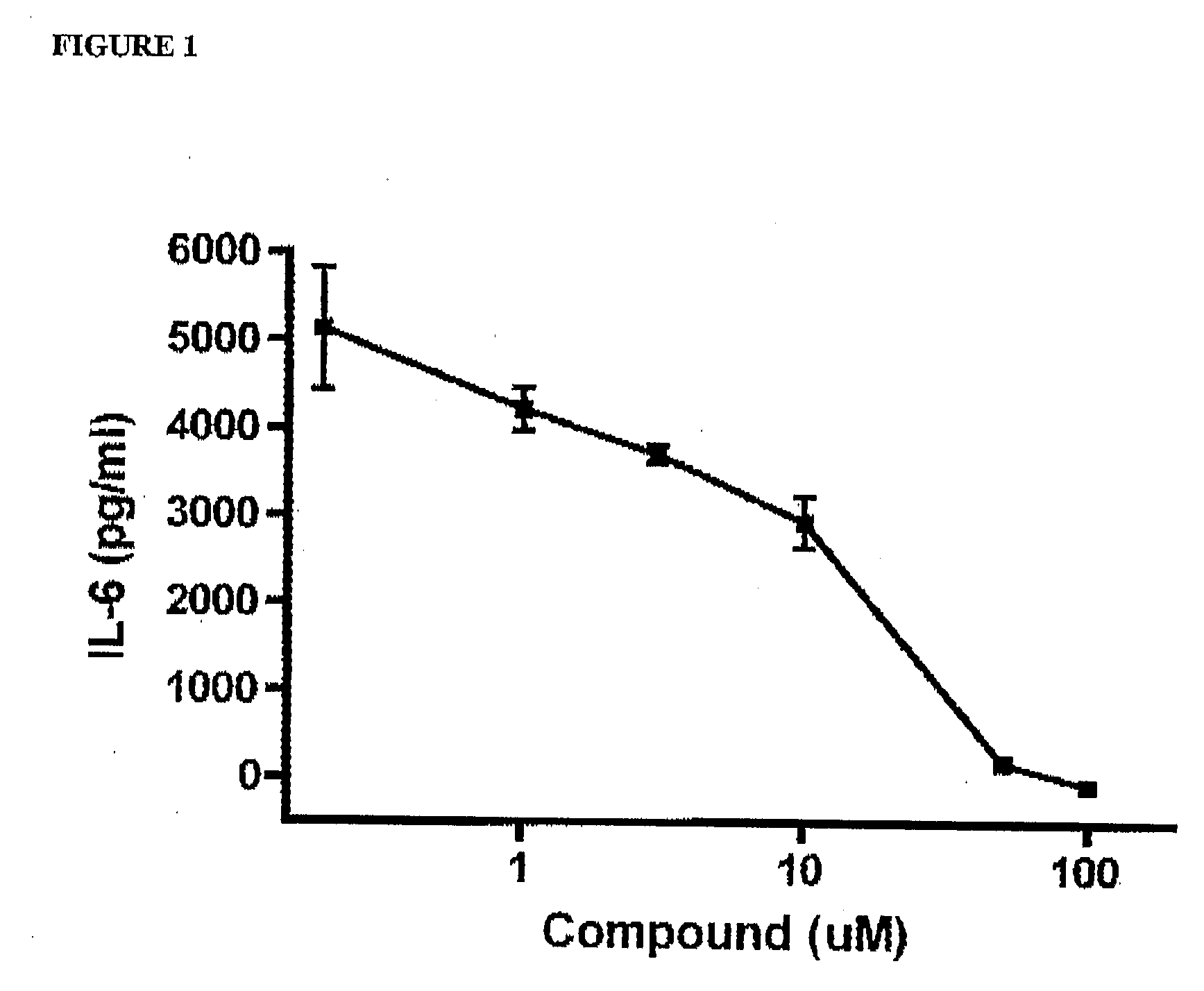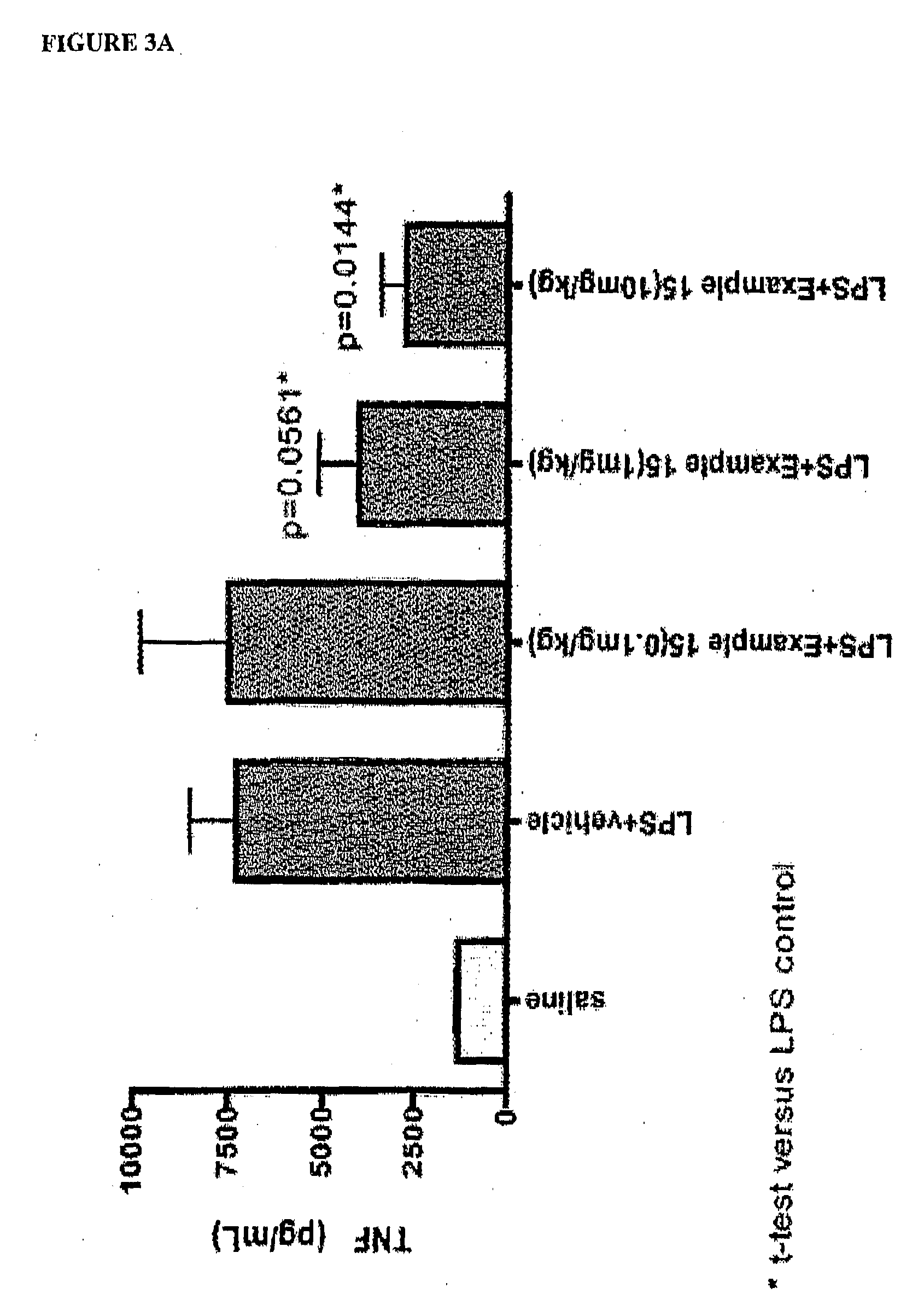MIF Inhibitors
a technology of mif and inhibitors, applied in the field of mif inhibitors, can solve the problems of limited universal use of glucocorticoids, inability to readily adapt to formulations, and high cost of biological molecules on a commercial basis, so as to reduce the severity of stent restenosis and inhibit the onset of restenosis
- Summary
- Abstract
- Description
- Claims
- Application Information
AI Technical Summary
Benefits of technology
Problems solved by technology
Method used
Image
Examples
example 8
[0244]
Preparation of 6-((2-oxo-2-(2-oxo-2,3-dihydro-1H-indol-5-yl)ethyl)thio)hexyl acetate (8)
[0245]A suspension of sodium hydride (0.237 g, 60% dispersion, 5.92 mmol) in anhydrous N,N-dimethylformamide (7 ml) was stirred at 0° C. for 5 min under nitrogen. 6-Mercapto-1-hexanol (0.059 ml, 0.43 mmol) was added and storing continued at 0° C. for 20 min then 5-chloroacetyloxindole (0.099 g, 0.474 mmol) was added and stirring continued at 0°G for a further 1 h. The suspension was then partitioned between ethyl acetate and water and the aqueous phase acidified with 1M hydrochloric acid and extracted with ethyl acetate. The combined organic phases were washed with 1M hydrochloric acid, water, brine, dried (MgSO4) and concentrated to give a sticky yellow solid (0.231 g). Purification by column chromatography (SiO2) eluting with 99:1 DCM / MeOH afforded the ester (8) as a white solid (0.085 g, 51%), mp. 86-87° C. (TLC: RF=0.44 on SiO2 with 9:1 DCM / McOH).
[0246]1H nmr (300 MHz, CDCl3) δ 1.38, m,...
example 9
[0248]
Preparation of 5-(((6-hydroxyhexyl)thio)acetyl)-1,3-dihydro-2H-indol-2-one (9)
[0249]After elution with 99:1 DCM / MeOH as described in example 8, further elution with 95:5 DCM / MeOH afforded the alcohol (9) as a pale beige solid (0.048 g, 30%), mp. 105-108° C. (TLC: RF=0.35 on SiO2 with 9:1 DCM / MeOH).
[0250]1H nmr (300 MHz, d6-dmso) δ 1.30-1.55, m, 4×CH2; 2.4, obscured, CH2S; 3.35, dt (5.1, 6.4 Hz). OCH2; 3.54, s, H3; 3.87, s, SCH2CO; 4.28, t (5.2 Hz), OH; 6.89, d (8.1 Hz), H7; 7.81, br s, H4; 7.87, dd (1.5, 8.3 Hz), H6; 10.73, s, NH.
[0251]ESI <+ve) m / z 330 (M+Na, 25%), 308 (M+H, 70%). ESI (−ve) m / z 306 (M−H, 60%).
example 10
[0252]
Preparation of 5-(((6-hydroxyhexyl)thio)acetyl)-1,3-dihydro-2H-benzimidazol-2-one (10)
[0253]To a solution of 6-mercapto-1-hexanol (0.51 g, 3.8 mmol) in tetrahydrofuran (30 ml) was added 5-(chloroacetyl)-1,3-dihydro-2H-benzimidazol-2-one (0.80 g, 3.8 mmol) from example 3, followed by dry potassium carbonate (2.62 g, 19.0 mmol, 5 eq) and the suspension stirred at room temperature for 96 h. The reaction mixture was partitioned between water (100 ml) and ethyl acetate (80 ml) and the aqueous layer re-extracted with ethyl acetate (80 ml). The combined organic extract was washed with water (1×100 ml), brine (1×100 ml), dried (MgSO4) and concentrated to a volume of 30-40 ml resulting in precipitation. The precipitate was filtered off to give the alcohol (10) as a pale yellow powder (0.658 g, 56%), mp. 180-181° C.
[0254]1H nmr (300 MHz, d6-dmso) δ 1.2-1.55, m, 4×CH2; 2.5, obscured, CH2S; 3.35, t (6.5 Hz), OCH2; 3.89, s, SCH2CO; 4.2, br s, OH; 6.99, d (8.1 Hz), H7; 7.48, d (1.2 Hz), H4;...
PUM
| Property | Measurement | Unit |
|---|---|---|
| Volume | aaaaa | aaaaa |
| Inhibition | aaaaa | aaaaa |
| Inhibition | aaaaa | aaaaa |
Abstract
Description
Claims
Application Information
 Login to View More
Login to View More - R&D
- Intellectual Property
- Life Sciences
- Materials
- Tech Scout
- Unparalleled Data Quality
- Higher Quality Content
- 60% Fewer Hallucinations
Browse by: Latest US Patents, China's latest patents, Technical Efficacy Thesaurus, Application Domain, Technology Topic, Popular Technical Reports.
© 2025 PatSnap. All rights reserved.Legal|Privacy policy|Modern Slavery Act Transparency Statement|Sitemap|About US| Contact US: help@patsnap.com



